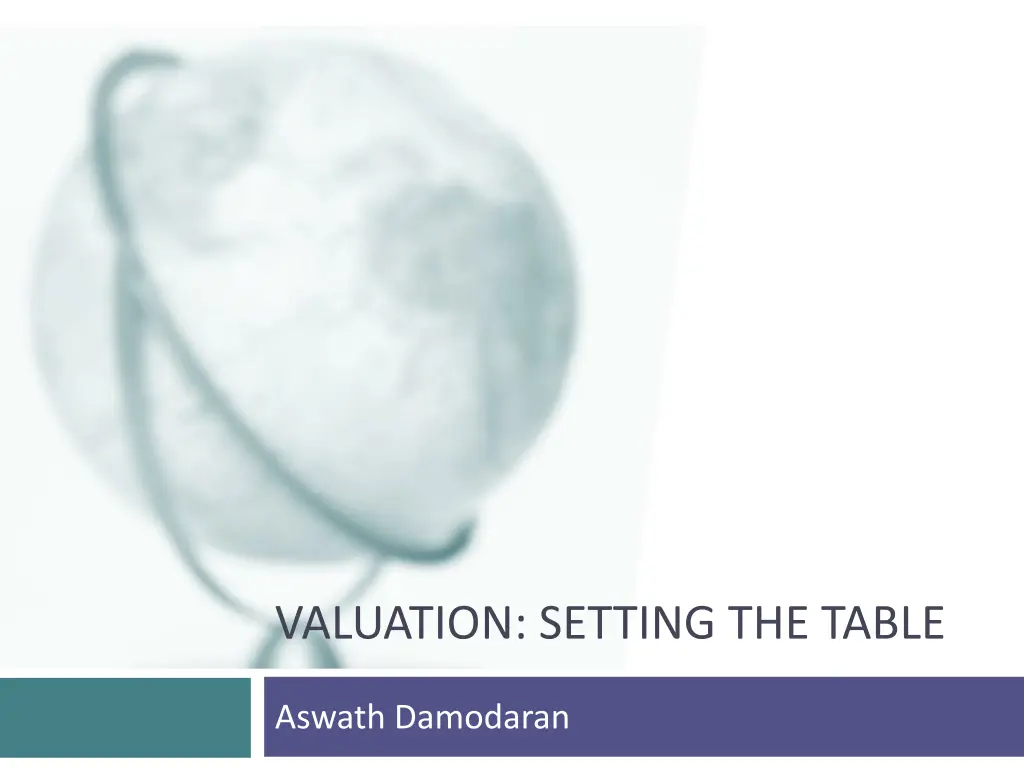
Understanding Valuation in Investment: Aswath Damodaran Insights
Explore Aswath Damodaran's perspectives on Valuation, characterizing it as a unique blend of science, art, and craft. Delve into the simplicity and universality of valuation methods, and the distinction between valuing an asset and pricing it. Discover how a good valuation combines storytelling with numerical analysis for a comprehensive assessment of investment opportunities.
Download Presentation

Please find below an Image/Link to download the presentation.
The content on the website is provided AS IS for your information and personal use only. It may not be sold, licensed, or shared on other websites without obtaining consent from the author. If you encounter any issues during the download, it is possible that the publisher has removed the file from their server.
You are allowed to download the files provided on this website for personal or commercial use, subject to the condition that they are used lawfully. All files are the property of their respective owners.
The content on the website is provided AS IS for your information and personal use only. It may not be sold, licensed, or shared on other websites without obtaining consent from the author.
E N D
Presentation Transcript
VALUATION: SETTING THE TABLE Aswath Damodaran
Theme 1: Characterizing Valuation as a discipline In a science, if you get the inputs right, you should get the output right. The laws of physics and mathematics are universal and there are no exceptions. Valuation is not a science. In an art, there are elements that can be taught but there is also a magic that you either have or you do not. The essence of an art is that you are either a great artist or you are not. Valuation is not an art. A craft is a skill that you learn by doing. The more you do it, the better you get at it. Valuation is a craft. 2
Theme 2: Valuation is simple & universal Ways of thinking about/estimating value Intrinsic Value The value of an asset is the present value of the expected cashflows Relative Value/ Pricing The value of an asset is what others are willing to pay for it (or something like it) Contingent Value The value of an asset may be contingent on what happens to other assets Investors - Small vs Large - Short term vs Long term - Individual vs Instiutional - Insider vs Outsider Value Enhacement - Management - Activist Investors Perspectives on value Changing Value Every asset has a value. We just have to find it. Analysts - Buy Side vs Sell Side Acquisitions - Synergy - Control Accountants Regulators/ Government And private businesses - For owners - And investors (private equity, venture capital, IPO) Across the life cycle - Young firms - IPOs - Mature firms - Declining firms In sickness and in health - Survival Risk - Distress Risk - Nationalization Risk Valuing publicly traded firms - Small vs Large - Developed vs Emerging - Manufacturing vs Technology Ways of Applying Value 3
Theme 3: Valuing an asset is not the same as pricing that asset Drivers of intrinsic value - Cashflows from existing assets - Growth in cash flows - Quality of Growth Drivers of price - Market moods & momentum - Surface stories about fundamentals Accounting Estimates THE GAP Is there one? If so, will it close? If it will close, what will cause it to close? PRICE INTRINSIC VALUE Price Value Valuation Estimates 4
Theme 4: Good valuation = Story + Numbers Favored Tools - Accounting statements - Excel spreadsheets - Statistical Measures - Pricing Data Favored Tools - Anecdotes - Experience (own or others) - Behavioral evidence A Good Valuation The Narrative People The Numbers People Illusions/Delusions 1. Creativity cannot be quantified 2. If the story is good, the investment will be. 3. Experience is the best teacher Illusions/Delusions 1. Precision: Data is precise 2. Objectivity: Data has no bias 3. Control: Data can control reality 5
Theme 5: If you value something, you should be willing to act on it.. There is very little theory in valuation and I am not sure what an academic valuation would like like and am not sure that I want to find out. Pragmatism, not purity: The end game is to estimate a value for an asset. I plan to get there, even if it means taking short cuts and making assumptions that would make purists blanch. To act on your valuations, you have to have faith in In your own valuation judgments. In markets: that prices will move towards your value estimates. That faith will have to be earned. 6
